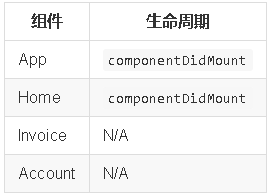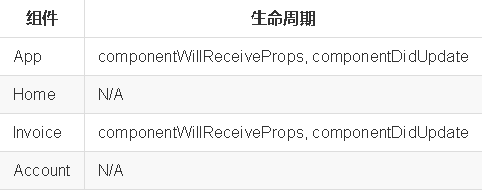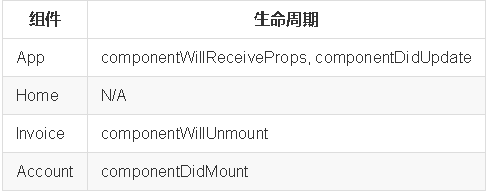react router
参考网站:http://react-guide.github.io/react-router-cn/docs/API.htmlapihttp://react-guide.github.io/react-router-cn/docs/API.html路由配置路由配置是一组指令,用来告诉 router 如何匹配 URL以及匹配后如何执行代码。添加首页想象一下当 URL 为/...
参考网站:API 文档 | React Router 中文文档
api
路由配置
路由配置是一组指令,用来告诉 router 如何匹配 URL以及匹配后如何执行代码。
添加首页
想象一下当 URL 为 / 时,我们想渲染一个在 App 中的组件。不过在此时,App 的 render 中的 this.props.children 还是 undefined。这种情况我们可以使用 IndexRoute 来设置一个默认页面。
import { IndexRoute } from 'react-router'
const Dashboard = React.createClass({
render() {
return <div>Welcome to the app!</div>
}
})
React.render((
<Router>
<Route path="/" component={App}>
{/* 当 url 为/时渲染 Dashboard */}
<IndexRoute component={Dashboard} />
<Route path="about" component={About} />
<Route path="inbox" component={Inbox}>
<Route path="messages/:id" component={Message} />
</Route>
</Route>
</Router>
), document.body)
让 UI 从 URL 中解耦出来
如果我们可以将 /inbox 从 /inbox/messages/:id 中去除,并且还能够让 Message 嵌套在 App ->Inbox 中渲染,那会非常赞。绝对路径可以让我们做到这一点。
React.render((
<Router>
<Route path="/" component={App}>
<IndexRoute component={Dashboard} />
<Route path="about" component={About} />
<Route path="inbox" component={Inbox}>
{/* 使用 /messages/:id 替换 messages/:id */}
<Route path="/messages/:id" component={Message} />
</Route>
</Route>
</Router>
), document.body)在多层嵌套路由中使用绝对路径的能力让我们对 URL 拥有绝对的掌控。我们无需在 URL 中添加更多的层级,从而可以使用更简洁的 URL。

提醒:绝对路径可能在动态路由中无法使用
兼容旧的 URL
等一下,我们刚刚改变了一个 URL! 这样不好。 现在任何人访问 /inbox/messages/5 都会看到一个错误页面。:(
不要担心。我们可以使用 <Redirect> 使这个 URL 重新正常工作(重新跳转)。
import { Redirect } from 'react-router'
React.render((
<Router>
<Route path="/" component={App}>
<IndexRoute component={Dashboard} />
<Route path="about" component={About} />
<Route path="inbox" component={Inbox}>
<Route path="/messages/:id" component={Message} />
{/* 跳转 /inbox/messages/:id 到 /messages/:id */}
<Redirect from="messages/:id" to="/messages/:id" />
</Route>
</Route>
</Router>
), document.body)
现在当有人点击 /inbox/messages/5 这个链接,他们会被自动跳转到 /messages/5。 :raised_hands:
进入和离开的Hook
Route 可以定义 onEnter 和 onLeave 两个 hook ,这些hook会在页面跳转确认时触发一次。这些 hook 对于一些情况非常的有用,例如权限验证或者在路由跳转前将一些数据持久化保存起来。
import { Redirect } from 'react-router'
React.render((
<Router>
<Route path="/" component={App}>
<IndexRoute component={Dashboard} />
<Route path="about" component={About} />
<Route path="inbox" component={Inbox}>
// 绑定route hook
<Route path="/messages/:id" component={Message} onEnter="(nextState, replaceState)=> { replaceState(null, '/messages/' + nextState.params.id)" />
<Redirect from="messages/:id" to="/messages/:id" />
</Route>
</Route>
</Router>
), document.body)
在路由跳转过程中,onLeave hook 会在所有将离开的路由中触发,从最下层的子路由开始直到最外层父路由结束。然后onEnter hook会从最外层的父路由开始直到最下层子路由结束。
继续我们上面的例子,如果一个用户点击链接,从 /messages/5 跳转到 /about,下面是这些 hook 的执行顺序:
/messages/:id的onLeave/inbox的onLeave/about的onEnter
替换的配置方式(使用原生 route 数组对象代替)
因为 route 一般被嵌套使用,所以使用 JSX 这种天然具有简洁嵌套型语法的结构来描述它们的关系非常方便。然而,如果你不想使用 JSX,也可以直接使用原生 route 数组对象。
上面我们讨论的路由配置可以被写成下面这个样子:
const routeConfig = [
{ path: '/',
component: App,
indexRoute: { component: Dashboard },
childRoutes: [
{ path: 'about', component: About },
{ path: 'inbox',
component: Inbox,
childRoutes: [
{ path: '/messages/:id', component: Message },
{ path: 'messages/:id',
onEnter: function (nextState, replaceState) {
replaceState(null, '/messages/' + nextState.params.id)
}
}
]
}
]
}
]
React.render(<Router routes={routeConfig} />, document.body)路由匹配原理
路由拥有三个属性来决定是否“匹配“一个 URL:
嵌套关系
React Router 使用路由嵌套的概念来让你定义 view 的嵌套集合,当一个给定的 URL 被调用时,整个集合中(命中的部分)都会被渲染。嵌套路由被描述成一种树形结构。React Router 会深度优先遍历整个路由配置来寻找一个与给定的 URL 相匹配的路由。
路径语法
路由路径是匹配一个(或一部分)URL 的 一个字符串模式。大部分的路由路径都可以直接按照字面量理解,除了以下几个特殊的符号:
:paramName– 匹配一段位于/、?或#之后的 URL。 命中的部分将被作为一个参数()– 在它内部的内容被认为是可选的*– 匹配任意字符(非贪婪的)直到命中下一个字符或者整个 URL 的末尾,并创建一个splat参数(下例就是匹配到 .* 为止)
<Route path="/hello/:name"> // 匹配 /hello/michael 和 /hello/ryan
<Route path="/hello(/:name)"> // 匹配 /hello, /hello/michael 和 /hello/ryan
<Route path="/files/*.*"> // 匹配 /files/hello.jpg 和 /files/path/to/hello.jpg
如果一个路由使用了相对路径,那么完整的路径将由它的所有祖先节点的路径和自身指定的相对路径拼接而成。使用绝对路径可以使路由匹配行为忽略嵌套关系。
优先级
最后,路由算法会根据定义的顺序自顶向下匹配路由。因此,当你拥有两个兄弟路由节点配置时,你必须确认前一个路由不会匹配后一个路由中的路径。例如,千万不要这么做:
<Route path="/comments" ... />
<Redirect from="/comments" ... />Histories
简而言之,一个 history 知道如何去监听浏览器地址栏的变化, 并解析这个 URL 转化为 location 对象, 然后 router 使用它匹配到路由,最后正确地渲染对应的组件。
常用的 history 有三种形式, 但是你也可以使用 React Router 实现自定义的 history。
browserHistory(浏览器history模式,类似vue的history模式)hashHistory(hash模式)createMemoryHistory(自定义history模式)
你可以从 React Router 中引入它们:
// JavaScript 模块导入(译者注:ES6 形式)
import { browserHistory } from 'react-router'
然后将它们传递给<Router>:
render(
<Router history={browserHistory} routes={routes} />,
document.getElementById('app')
)browserHistory
Browser history 是使用 React Router 的应用推荐的 history。它使用浏览器中的 History API 用于处理 URL,创建一个像example.com/some/path这样真实的 URL 。
服务器配置
服务器需要做好处理 URL 的准备。处理应用启动最初的 / 这样的请求应该没问题,但当用户来回跳转并在 /accounts/123 刷新时,服务器就会收到来自 /accounts/123 的请求,这时你需要处理这个 URL 并在响应中包含 JavaScript 应用代码(对每个路径都要有相应处理)。
IE8, IE9 支持情况
如果我们能使用浏览器自带的 window.history API,那么我们的特性就可以被浏览器所检测到。如果不能,那么任何调用跳转的应用就会导致 全页面刷新,它允许在构建应用和更新浏览器时会有一个更好的用户体验,但仍然支持的是旧版的。
你可能会想为什么我们不后退到 hash history,问题是这些 URL 是不确定的。如果一个访客在 hash history 和 browser history 上共享一个 URL,然后他们也共享同一个后退功能,最后我们会以产生笛卡尔积数量级的、无限多的 URL 而崩溃。
hashHistory
Hash history 使用 URL 中的 hash(#)部分去创建形如 example.com/#/some/path 的路由。
我应该使用 createHashHistory吗?
Hash history 不需要服务器任何配置就可以运行,如果你刚刚入门,那就使用它吧。但是我们不推荐在实际线上环境中用到它,因为每一个 web 应用都应该渴望使用 browserHistory。
像这样 ?_k=ckuvup 没用的在 URL 中是什么?(history和hash模式下参数的保存)
当一个 history 通过应用程序的 push 或 replace 跳转时,它可以在新的 location 中存储 “location state” 而不显示在 URL 中,这就像是在一个 HTML 中 post 的表单数据。
在 DOM API 中,这些 hash history 通过 window.location.hash = newHash 很简单地被用于跳转,且不用存储它们的location state。但我们想全部的 history 都能够使用location state,因此我们要为每一个 location 创建一个唯一的 key,并把它们的状态存储在 session storage 中。当访客点击“后退”和“前进”时,我们就会有一个机制去恢复这些 location state。
createMemoryHistory
Memory history 不会在地址栏被操作或读取。这就解释了我们是如何实现服务器渲染的。同时它也非常适合测试和其他的渲染环境(像 React Native )。
和另外两种history的一点不同是你必须创建它,这种方式便于测试。
const history = createMemoryHistory(location)
实现示例
import React from 'react'
import { render } from 'react-dom'
import { browserHistory, Router, Route, IndexRoute } from 'react-router'
import App from '../components/App'
import Home from '../components/Home'
import About from '../components/About'
import Features from '../components/Features'
render(
<Router history={browserHistory}>
<Route path='/' component={App}>
<IndexRoute component={Home} />
<Route path='about' component={About} />
<Route path='features' component={Features} />
</Route>
</Router>,
document.getElementById('app')
)默认路由(IndexRoute)与 IndexLink
场景:首页
<Router>
<Route path="/" component={App}>
<IndexRoute component={Home}/>
<Route path="accounts" component={Accounts}/>
<Route path="statements" component={Statements}/>
</Route>
</Router>
现在 App 能够渲染 {this.props.children} 了值为home, 我们也有了一个最高层级的路由,使 Home 可以参与进来。
Index Links
如果你在这个 app 中使用 <Link to="/">Home</Link> , 它会一直处于激活状态,因为所有的 URL 的开头都是 / 。 这确实是个问题,因为我们仅仅希望在 Home 被渲染后,激活并链接到它。
如果需要在 Home 路由被渲染后才激活的指向 / 的链接(只有当前的link是激活的),请使用 <IndexLink to="/">Home</IndexLink>
动态路由
对于大型应用来说,一个首当其冲的问题就是所需加载的 JavaScript 的大小。(采用按需加载,懒加载)
路由是个非常适于做代码分拆的地方:它的责任就是配置好每个 view。
React Router 里的路径匹配以及组件加载都是异步完成的,不仅允许你延迟加载组件,并且可以延迟加载路由配置。在首次加载包中你只需要有一个路径定义,路由会自动解析剩下的路径。
Route 可以定义 getChildRoutes,getIndexRoute 和 getComponents 这几个函数。它们都是异步执行,并且只有在需要时才被调用。我们将这种方式称之为 “逐渐匹配”。 React Router 会逐渐的匹配 URL 并只加载该 URL 对应页面所需的路径配置和组件。
const CourseRoute = {
path: 'course/:courseId',
getChildRoutes(location, callback) {
require.ensure([], function (require) {
callback(null, [
require('./routes/Announcements'),
require('./routes/Assignments'),
require('./routes/Grades'),
])
})
// 或者使用import()
()=> {
Promise.all([
import('./routes/Announcements'),
import('./routes/Assignments'),
import('./routes/Grades')
])
}
},
getIndexRoute(location, callback) {
require.ensure([], function (require) {
callback(null, require('./components/Index'))
})
},
getComponents(location, callback) {
require.ensure([], function (require) {
callback(null, require('./components/Course'))
})
}
}跳转前确认
React Router 提供一个 routerWillLeave 生命周期钩子,这使得 React 组件可以拦截正在发生的跳转,或在离开 route 前提示用户。routerWillLeave 返回值有以下两种:
return false取消此次跳转return返回提示信息,在离开 route 前提示用户进行确认。
你可以在 route 组件 中引入 Lifecycle mixin 来安装这个钩子。
import { Lifecycle } from 'react-router'
const Home = React.createClass({
// 假设 Home 是一个 route 组件,它可能会使用
// Lifecycle mixin 去获得一个 routerWillLeave 方法。
mixins: [ Lifecycle ],
routerWillLeave(nextLocation) {
if (!this.state.isSaved)
return 'Your work is not saved! Are you sure you want to leave?'
},
// ...
})如果你在组件中使用了 ES6 类,你可以借助 react-mixin 包将 Lifecycle mixin 添加到组件中,不过我们推荐使用 React.createClass 来创建组件,初始化路由的生命周期钩子函数。
如果你想在一个深层嵌套的组件中使用 routerWillLeave 钩子,只需在 route 组件 中引入 RouteContextmixin,这样就会把 route 放到 context 中。
import { Lifecycle, RouteContext } from 'react-router'
const Home = React.createClass({
// route 会被放到 Home 和它子组件及孙子组件的 context 中,
// 这样在层级树中 Home 及其所有子组件都可以拿到 route。
mixins: [ RouteContext ],
render() {
return <NestedForm />
}
})
const NestedForm = React.createClass({
// 后代组件使用 Lifecycle mixin 获得
// 一个 routerWillLeave 的方法。
mixins: [ Lifecycle ],
routerWillLeave(nextLocation) {
if (!this.state.isSaved)
return 'Your work is not saved! Are you sure you want to leave?'
},
// ...
})组件生命周期
路由切换时,组件生命周期的变化情况
1. 当用户打开应用的 '/' 页面

2. 当用户从 '/' 跳转到 '/invoice/123'

App从 router 中接收到新的 props(例如children、params、location等数据), 所以App触发了componentWillReceiveProps和componentDidUpdate两个生命周期方法Home不再被渲染,所以它将被移除Invoice首次被挂载
3. 当用户从 /invoice/123 跳转到 /invoice/789

4. 当从 /invoice/789 跳转到 /accounts/123

获取数据
虽然还有其他通过 router 获取数据的方法, 但是最简单的方法是通过组件生命周期 Hook 来实现。 前面我们已经理解了当路由改变时组件生命周期的变化, 我们可以在 Invoice 组件里实现一个简单的数据获取功能。
let Invoice = React.createClass({
getInitialState () {
return {
invoice: null
}
},
componentDidMount () {
// 上面的步骤2,在此初始化数据
this.fetchInvoice()
},
componentDidUpdate (prevProps) {
// 上面步骤3,通过参数更新数据
let oldId = prevProps.params.invoiceId
let newId = this.props.params.invoiceId
if (newId !== oldId)
this.fetchInvoice()
},
componentWillUnmount () {
// 上面步骤四,在组件移除前忽略正在进行中的请求
this.ignoreLastFetch = true
},
fetchInvoice () {
let url = `/api/invoices/${this.props.params.invoiceId}`
this.request = fetch(url, (err, data) => {
if (!this.ignoreLastFetch)
this.setState({ invoice: data.invoice })
})
},
render () {
return <InvoiceView invoice={this.state.invoice}/>
}
})在组件外部使用导航
虽然在组件内部可以使用 this.context.router 来实现导航,但许多应用想要在组件外部使用导航。使用Router组件上被赋予的history可以在组件外部实现导航。
// your main file that renders a Router
import { Router, browserHistory } from 'react-router'
import routes from './app/routes'
render(<Router history={browserHistory} routes={routes}/>, el)
// somewhere like a redux/flux action file:
import { browserHistory } from 'react-router'
browserHistory.push('/some/path')如何获得上一次路径?
通过props.location获取路径
<Route component={App}>
{/* ... 其它 route */}
</Route>
const App = React.createClass({
getInitialState() {
return { showBackButton: false }
},
componentWillReceiveProps(nextProps) {
const routeChanged = nextProps.location !== this.props.location
this.setState({ showBackButton: routeChanged })
}
})特殊api说明
Route
getComponent(location, callback)
与 component 一样,但是是异步的,对于 code-splitting 很有用。
callback signature
cb(err, component)
<Route path="courses/:courseId" getComponent={(location, cb) => {
// 做一些异步操作去查找组件
cb(null, Course)
}}/>
getComponents(location, callback)
与 component 一样,但是是异步的,对于 code-splitting 很有用。
callback signature
cb(err, components)
<Route path="courses/:courseId" getComponent={(location, cb) => {
// 做一些异步操作去查找组件
cb(null, {sidebar: CourseSidebar, content: Course})
}}/>onEnter(nextState, replaceState, callback?)
当 route 即将进入时调用。它提供了下一个路由的 state,一个函数重定向到另一个路径。this 会触发钩子去创建 route 实例。
当 callback 作为函数的第三个参数传入时,这个钩子将是异步执行的,并且跳转会阻塞直到 callback 被调用。
onLeave()
当 route 即将退出时调用
Route Components
当 route 匹配到 URL 时会渲染一个 route 的组件。路由会在渲染时将以下属性注入组件中:
history
Router 的 history history。
对于跳转很有用的 this.props.history.pushState(state, path, query)(跳转操作)
location
当前的 location。
params
URL 的动态段。
route
渲染组件的 route。
routeParams
this.props.params 是直接在组件中指定 route 的一个子集。例如,如果 route 的路径是 users/:userId而 URL 是 /users/123/portfolios/345,那么 this.props.routeParams 会是 {userId: '123'},并且 this.props.params 会是 {userId: '123', portfolioId: 345}。
children
匹配到子 route 的元素将被渲染。如果 route 有已命名的组件,那么此属性会是 undefined,并且可用的组件会被直接替换到 this.props 上。
示例
render((
<Router>
<Route path="/" component={App}>
<Route path="groups" component={Groups} />
<Route path="users" component={Users} />
</Route>
</Router>
), node)
class App extends React.Component {
render() {
return (
<div>
{/* 这可能是 <Users> 或 <Groups> */}
{this.props.children}
</div>
)
}
}已命名的组件(一个路由下面多个组件)
当一个 route 有一个或多个已命名的组件时,其子元素的可用性是通过 this.props 命名的。因此 this.props.children 将会是 undefined。那么所有的 route 组件都可以参与嵌套。
示例
render((
<Router>
<Route path="/" component={App}>
<Route path="groups" components={{main: Groups, sidebar: GroupsSidebar}} />
<Route path="users" components={{main: Users, sidebar: UsersSidebar}}>
<Route path="users/:userId" component={Profile} />
</Route>
</Route>
</Router>
), node)
class App extends React.Component {
render() {
// 在父 route 中,被匹配的子 route 变成 props
return (
<div>
<div className="Main">
{/* 这可能是 <Groups> 或 <Users> */}
{this.props.main}
</div>
<div className="Sidebar">
{/* 这可能是 <GroupsSidebar> 或 <UsersSidebar> */}
{this.props.sidebar}
</div>
</div>
)
}
}
class Users extends React.Component {
render() {
return (
<div>
{/* 如果在 "/users/123" 路径上这会是 <Profile> */}
{/* UsersSidebar 也会获取到作为 this.props.children 的 <Profile> 。
你可以把它放这渲染 */}
{this.props.children}
</div>
)
}
}History Mixin
在组件中添加路由的 history 对象。
注意:你的 route components 不需要这个 mixin,它在 this.props.history 中已经是可用的了。这是为了组件更深次的渲染树中需要访问路由的 history 对象。
Methods
pushState(state, pathname, query)
跳转至一个新的 URL。
arguments
state- location 的 state。即新的路由内组件的state属性pathname- 没有 query 完整的 URL。query- 通过路由字符串化的一个对象。
replaceState(state, pathname, query)
在不影响 history 长度的情况下(如一个重定向),用新的 URL 替换当前这个。
参数
state- location 的 state。pathname- 没有 query 完整的 URL。query- 通过路由字符串化的一个对象。
go(n)
在 history 中使用 n 或 -n 进行前进或后退
goBack()
在 history 中后退。
goForward()
在 history 中前进。
createPath(pathname, query)
使用路由配置,将 query 字符串化加到路径名中。
createHref(pathname, query)
使用路由配置,创建一个 URL。例如,它会在 pathname 的前面加上 #/ 给 hash history。
isActive(pathname, query, indexOnly)
根据当前路径是否激活返回 true 或 false。通过 pathname 匹配到 route 分支下的每个 route 将会是 true(子 route 是激活的情况下,父 route 也是激活的),除非 indexOnly 已经指定了,在这种情况下,它只会匹配到具体的路径。
参数
pathname- 没有 query 完整的 URL。query- 如果没有指定,那会是一个包含键值对的对象,并且在当前的 query 中是激活状态的 - 在当前的 query 中明确是undefined的值会丢失相应的键或undefinedindexOnly- 一个 boolean(默认:false)。
示例
import { History } from 'react-router'
React.createClass({
mixins: [ History ],
render() {
return (
<div>
<div onClick={() => this.history.pushState(null, '/foo')}>Go to foo</div>
<div onClick={() => this.history.replaceState(null, 'bar')}>Go to bar without creating a new history entry</div>
<div onClick={() => this.history.goBack()}>Go back</div>
</div>
)
}
})
假设你正在使用 bootstrap,并且在 Tab 中想让那些 li 获得 active:
import { Link, History } from 'react-router'
const Tab = React.createClass({
mixins: [ History ],
render() {
let isActive = this.history.isActive(this.props.to, this.props.query)
let className = isActive ? 'active' : ''
return <li className={className}><Link {...this.props}/></li>
}
})
// 如 <Link/> 一样使用它,你会得到一个包进 `li` 的锚点
// 并且还有一个自动的 `active` class。
<Tab href="foo">Foo</Tab>问题集锦
react-router-native、react-router和react-router-dom的区别
react-router: 实现了路由的核心功能react-router-dom: 基于react-router,加入了在浏览器运行环境下的一些功能,例如:Link组件,会渲染一个a标签,Link组件源码a标签行; BrowserRouter和HashRouter组件,前者使用pushState和popState事件构建路由,后者使用window.location.hash和hashchange事件构建路由。
react-router-native: 基于react-router,类似react-router-dom,加入了react-native运行环境下的一些功能。
更多推荐
 已为社区贡献1条内容
已为社区贡献1条内容








所有评论(0)